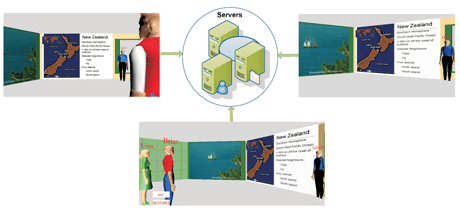by Gavin McArdle, Teresa Monahan and Michela Bertolotto
The provision of learning facilities online is a convenient way for students to partake in education. This form of e-learning is currently in widespread use and is continually growing in popularity. The CLEV-R research group within the School of Computer Science and Informatics at University College Dublin, Ireland, are examining ways of enhancing students' e-learning experiences by providing interactive methods for accessing e-learning material. Of particular interest is support for a learning community, which permits collaborative learning techniques and fosters social interaction between students. A combination of 3D multi-user environments and instant communication techniques are employed to achieve this.
Current Web-based e-learning applications tend to focus on the management of learning material and students' access to it. They offer mechanisms for tutors to easily monitor students' actions and assess their progress throughout a course. However, studies show a high attrition rate among courses that are run solely using these techniques. Lack of motivation and stimulation for students as well as little support for interaction and communication with others contribute to this high drop-out rate. Many of the e-learning solutions currently available present the learning material in a plain-text format which fails to engage the student. Furthermore, communication facilities, if present in such e-learning applications, are often asynchronous. This can lead to a sense of isolation and loneliness for students. This issue is further exacerbated by the fact that social interaction between students, which is prevalent in a traditional classroom based learning scenario, is also absent.

The Collaborative Learning Environments with Virtual Reality (CLEV-R) project at UCD addresses these issues by using a range of technology to support learning while also engaging and stimulating students. Communication technology is used to remove feelings of solitude and introduce collaborative and social aspects to e-learning. Our group is also exploring the possibility of extending these facilities to a mobile platform that would enable users to access learning material and partake in collaborative learning activities without having to remain in a fixed location.
The use of onscreen three-dimensional (3D) graphics to provide an interface to access e-learning content marks CLEV-Rs main departure from mainstream e-learning applications. The interface mimics a university setting and provides the tools and features found in a real university. For example, virtual classrooms, meeting rooms, social areas and a library are all available to students. While the 3D graphics engage the student and offer a novel and exciting means of interaction, the key to the CLEV-R interface is the multi-user features it provides. Each student and tutor takes on the role of a character within a 3D environment; each character and their actions are visible to all users of the system. This creates an awareness of others and removes the sense of isolation often experienced with mainstream e-learning applications. The multi-user aspects of the 3D interface are supported by a number of synchronous communication facilities; these allow students and tutors to interact with each other in real time using a combination of voice and text chat. A mobile interface entitled mCLEV-R supplements this desktop application by providing students with access to the learning facilities via mobile devices. It provides a 3D interface to the learning services via a single-user 3D office-style environment. While the multi-user aspects of the 3D environment in the desktop application are not supported in mCLEV-R, synchronous text and audio communication technology is provided, which allows users to converse in real time.
One of the most powerful features of CLEV-R is the lecture room. This room allows a tutor to present a lecture to a group of students simultaneously. The room contains a presentation board where lecture slides can be displayed, and a media board that can be used to present audio and video material. Instant communication allows a tutor to talk directly to the class and so present a lecture in much the same way as they would in the real world. A live webcam feed can also be utilized to further enhance the learning experience. Additionally, students can use their microphones to talk to the tutor and ask questions. Supplementing these synchronous learning techniques, a library offers a means of individual learning by providing access to learning material. The 3D environment also contains meeting rooms which provide tools for collaboration among students. Presentation and media boards allow them to share their work, and they can communicate using real-time text and audio communication techniques. As social interaction is an important factor for students, the 3D environment has dedicated areas where students can meet informally. Students can use the instant communication tools in coffee areas to chat to their friends while more specialized tools in social rooms allow them to share photos and videos. Mobile users can also participate in these activities. Through the 3D interface, they can access learning material and course announcements. The real-time communication technology enables them to listen to live lecture commentary, participate in group learning activities and socialize with their peers.
Prototypes of both CLEV-R and mCLEV-R have now been developed, and a user evaluation study was carried out to ascertain peoples reaction to them. As expected, the 3D and synchronous communication technology was seen as valuable for engaging students and creating a sense of community for them. These results provide encouragement for the continued exploration of such technology for e-learning and m-learning.
Link:
http://www.cs.ucd.ie/
Please contact:
Gavin McArdle
University College Dublin, Ireland
Tel: +353 1 716 2483
E-mail: gavin.mcardle![]() ucd.ie
ucd.ie










